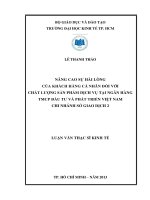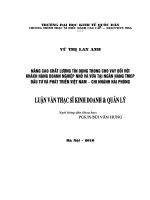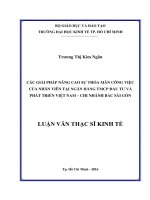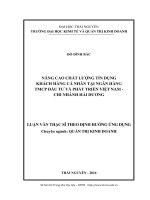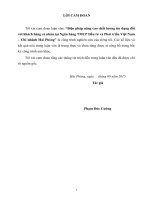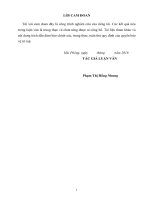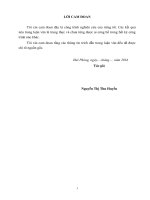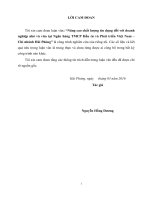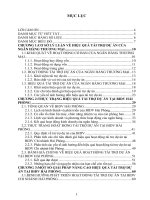Nâng cao năng lực làm việc của giao dịch viên tại ngân hàng TMCP đầu tư và phát triển việt nam – chi nhánh hải phòng e
Bạn đang xem bản rút gọn của tài liệu. Xem và tải ngay bản đầy đủ của tài liệu tại đây (529.68 KB, 88 trang )
Nguyen Thi Thu Ha, VN1001509
“Improving working competence of tellers in the Joint
Stock Commercial Bank for Investment and Development
of Vietnam – Hai Phong Branch”
-1-
DECLARATION OF AUTHORSHIP
I hereby declare the thesis “Improving working competence of tellers in the Joint
Stock Commercial Bank for Investment and Development of Vietnam – Hai Phong
Branch”is my work under the guidance of Doctor Pham Thi Nhuan .
The contents are summarized in the learning process, the data on the subject are
honestly obtained through implementing experiments which accurate and truly follow
scientific logic .
This thesis has not been published in any research project
Author
-1-
ACKNOWLEDGEMENT
I sincerely thank Doctor Pham Thi Nhuan who has dedicatedly supported me with
valuable guidance, suggestions to complete my dissertation “Improving working
competence of tellers in the Joint Stock Commercial Bank for Investment and
Development of Vietnam – Hai Phong Branch”
I am grateful to all teachers who have taught me knowledge for two years of
graduate program;
I am forever thankful to my family and my classmates at IEMBA HO3 who have
shown their great support during the time of study and research.
Yours sincerely!
Author
-2-
TABLE OF CONTENT
TABLE OF CONTENT.................................................................................................ii
LIST OF TABLES.......................................................................................................... ii
LIST OF CHARTS & FIGURES...................................................................................ii
L IST OF ABBREVIATIONS........................................................................................ii
PREFACE......................................................................................................................2
1. The necessity of chosen topic.................................................................................2
2. Purposes research thesis.........................................................................................2
3. Research scope and object .....................................................................................2
4. Research method....................................................................................................2
5. Significance of research topic.................................................................................2
6. Thesis structure.......................................................................................................2
CHAPTER I. THEORETICAL BASES OF WORKING COMPETENCE OF BANK
TELLERS....................................................................................................................... 2
1.1. WORKING COMPETENCE..............................................................................2
1.1.1 Definition of working competence................................................................2
1.1.2. Roles of working capacity assessment..........................................................2
1.1.2.1. Roles of working capacity assessment to employees.............................2
1.1.2.2. Roles of working capacity assessment to an organization......................2
1.1.2.3. Roles of working capacity assessment to economy................................2
1.1.3. Working capacity assessment model.............................................................2
-3-
1.1.3.1. ASK model introduction........................................................................2
1..1.3.2. Elements of ASK model.......................................................................2
1.2. Banking institutions and bank teller....................................................................2
1.2.1. Commercial bank definition.........................................................................2
1.2.2. Bank teller definition....................................................................................2
1.3. Working capacity assessment of bank teller........................................................2
1.3.1. Factors contributing to working capacity of bank teller................................2
1.3.1.1. Attitude..................................................................................................2
1.3.1.2. Skill.......................................................................................................2
1.3.1.3. Knowledge.............................................................................................2
1.3.2. Significance of implementation of working capacity assessment model..........2
1.3.2.1. Significance to banking institutions...............................................................2
Significance to banking institutions............................................................................2
1.3.3.2. Significance to bank teller.........................................................................2
1.3.3.3. Significance to banking customers............................................................2
1.4. Design assessment with opinions of bank manager, bank teller and customer....2
CHAPTER II. CURRENT STATUS OF WORKING COMPETENCE OF BANK
TELLERS AT BIDV – HAI PHONG BRANCH............................................................2
2.1. Introduction of BIDV – Hai Phong branch..........................................................2
2.1.1. History of establishment & development......................................................2
2.1.2. Organization model......................................................................................2
2.1.3. Business results of BIDV - Hai Phong branch in period 2012 – 2014.........2
-4-
2.2. Assessment of working capacity of bank teller at BIDV - Hai Phong Branch....2
2.2.1. General assessment of working capacity of bank teller at BIDV - Hai
Phong Branch.........................................................................................................2
2.2.2. Assessment of working capacity of bank teller at BIDV - Hai Phong Branch
through research tools.............................................................................................2
2.2.2.1. Feedback from BIDV managers about working capacity of bank teller2
2.2.2.2. Feedback from bank tellers....................................................................2
2.2.2.3. Feedback from customers......................................................................2
2.3. Discussion about working capacity of bank tellers at BIDV – Hai Phong branch
.................................................................................................................................... 2
2.3.1. Strength........................................................................................................2
2.3.2. Existing limitations and causes of problems.................................................2
CHAPTER III. SOLUTIONS TO ENHANCE WORK PERFORMANCE OF BANK
TELLERS AT BIDV – HAI PHONG BRANCH............................................................2
3.1. Orientation of development goals of BIDV – Hai Phong branch.........................2
3.1.1 Orientation of development goals of BIDV.......................................................2
3.1.2. Orientation of development goals of BIDV – Hai Phong branch..................2
3.2. Solutions to enhance the work performance of bank teller at BIDV – Hai Phong
branch......................................................................................................................... 2
3.2.1. Enhance job performance of bank tellers through changing working
attitudes..................................................................................................................2
3.2.2. Improvement communication skills of tellers...............................................2
3.2.3. Organization the professional training for tellers .........................................2
-5-
3.2.4. The solution for the organization and management and use of staff.............2
3.2.5. Other solutions..............................................................................................2
3.3. Some suggestions Recommendations for BIDV..................................................2
CONCLUSION..............................................................................................................2
REFERENCE................................................................................................................. ii
-6-
LIST OF TABLES
Table 2.1: The business results of BIDV Haiphong in period 2012-2014.......................2
Table 2.2. Number of tellers at main office and transaction offices of BIDV Hai Phong
....................................................................................................................................... 2
Table 2.3. Number of tellers by genders:........................................................................2
Table 2.4. Structure of the number of tellers by age.......................................................2
Table 2.5. Education level of tellers at BIDV Hai Phong Branch...................................2
Bảng 2.6. Summary of foreign language, IT skills of tellers at BIDV Hai Phong..........2
Table 2.7. Years of service in BIDV...............................................................................2
Table 2.9:Feedback from BIDV managers about working capacity of bank teller.........2
Table 2.10: Results of feedback from bank tellers..........................................................2
Table 2.11. Ages of surveyed customers.........................................................................2
Table 2.12. Years of using BIDV and some credit institutions that customers are using
as follows.......................................................................................................................2
Table 2.13: Feedback from customers on tellers at BIDV Hai Phong.............................2
Table 2.14: Summary of results of survey from customers, managers, tellers................2
Table 2.15. Summary of reviews from customers through Customers Service about
tellers of BIDV Haiphong from 2012 to 2014................................................................2
Table 3.1: Proposed training program for building work competence............................2
-7-
LIST OF CHARTS & FIGURES
Figure 1.1. ASK Model for capacity assessment............................................................2
Figure 1.2. The ladder of career growth of bank tellers..................................................2
Figure 1.3: Three components of attitude.......................................................................2
Figure 2.1: Organizational Chart BIDV Hai Phong........................................................2
Figure 2.2: Feedback from BIDV managers about working capacity of tellers..............2
Graphic2.3: Results of feedback from bank tellers.........................................................2
Figure 2.4: Feedback from customers.............................................................................2
Figure 2.5: Results of feedback from customers on tellers.............................................2
-8-
LIST OF ABBREVIATIONS
BIDV Hai Phong:
BIDV Hai Phong Branch
BIDV:
Back for Investment and Development of Vietnam JSC
GDV
Teller
NH
Bank
NHNN
State Bank
NHTM
Commercial Bank
TTCSKH
Customer Service Center
-9-
PREFACE
1. The necessity of chosen topic
The world has entered a new era of economic integration and globalization
which has become an inevitable trend and increasingly drawn attention of a great
number of countries. Banking institutions are not definitely out of this general trend. In
banking business activities, customers usually interact with bank tellers; therefore, their
attitude and working style has a decisive effect on the image and reputation of a bank.
Therefore, knowledge, experience, service attitude, ability to convince
customers, appearance and dress code can increase or decrease service quality.
Nowadays, due to the arrival of a variety of both foreign and domestic commercial
banks, the technological level and banking products offered by banks almost have no
difference, commercial banks can only enhance their competitiveness by increasing
quality of staff’s service. The higher the service quality is, the better competitive
advantage the bank achieves.
In short, customers’ loyalty depends heavily on
their impression when
interacting with the bank’s employees. There are many customers who conduct
banking transactions with a bank for a short time decide to switch to another bank
because of their dissatisfaction with the customer services offered by the former bank..
How can banks both retain existing customers and attract more new ones? The
service quality of a bank teller is an important factor which creates customer’s good
impression and makes significant contributions to customer’s decision on whether to
use the services of a bank or not. In particular, bank tellers are the ones who interact
with customers on the most regular basis. They are considered as a bank’s ambassadors
to build its image, brand name as well as its culture.
Determining quality of service and working style of teller team is one of the
important factors to attract customers and improve the competitiveness of BIDV. In
-1-
recent years, BIDV has focused on creating a good image for this team. Currently
quality of bank tellers at BIDV - Hai Phong Branch has has many positive changes, but
it has not yet met standards set by management board . Some officials have low
qualifications and weakness in communication skills, customer service attitude which
has not demonstrated professionalism of BIDV.
Being aware of the importance of bank tellers in operation of banking industry
and some existing limitations in their performance of customer service, the author
decided to choose the thesis with the title:
“Improving working competence of tellers in the Joint Stock Commercial
Bank for Investment and Development of Vietnam – Hai Phong Branch”
2. Purposes research thesis.
With the topic, the research has the following purposes:
(1). Systemize the theoretical basis about improving staff’s working competence
and capacity in business organizations.
(2). Analyze to assess the status of working capacity of bank teller staff at
BIDV- Hai Phong branch to point out the strengths, weaknesses and causes of existing
problems.
(3) Propose a number of measures of improving bank tellers’ working
competence at BIDV - Hai Phong branch and some proposals to implement the
measures mentioned above.
3. Research scope and subject.
- Research scope:
Data is going to be collected within the period of 2012-2014.
Time to carry out the study is from July 1st, 2015 to September 1st, 2015.
- Research subject: 45 bank tellers working at BIDV – Hai Phong Branch
4. Research method.
• Research procedure:
-2-
Theory and the reality of the banking operations are combined. In this study, the
statistical survey method is used with the subject of 10 administrators, 45 tellers and
100 customers of the bank. Process can be generalized through the following steps:
- Identify research subject
- Design research through questionnaires and surveys
- Gather information and data
- Make data analysis based on the survey results
- Make conclusions about the research results
• Secondary data collection:
The theoretical and practical bases through information about banking activities
of BIDV - Haiphong branch are collected. This information will be collected from the
bank's websites and internal reports (period of 2012-2014).
• Primary data collection with the aim of assessing tellers’ competence based on:
- Bank managers’ opinions and solutions (obtained through interviews)
- Tellers’ self-assessment opinions
- Customers’ opinions and suggestions, who make transactions at the banks.
• Data Processing: The information and data collected above are processed
through excel software, and then compared and analyzed; and conclusions are drawn to
offer proper solutions.
5. Significance of research topic.
Based on the analysis and assessment of the bank teller staff’s working capacity
at BIDV - Hai Phong branch, this research will point out their strengths and
weaknesses, which will help the bank managers have
a general overview on
achievements and limitations which need remedying. As a result, several measures may
be promptly proposed to enhance tellers’ working competence, which make a
contribution to improving customer service quality and making a good impression and
reputation of BIDV within banking industry.
-3-
6. Thesis structure
Excluding the introduction, conclusion, appendix, charts and figures, reference,
the report is divided into 3 main chapters:
Chapter 1: Theoretical bases for working capacity of bank tellers.
Chapter 2: Current status of the working capacity of bank tellers at BIDV Haiphong branch.
Chapter 3: Solutions to enhance work performance of bank tellers at BIDV- Hai
Phong branch.
-4-
CHAPTER I. THEORETICAL BASES OF WORKING COMPETENCE
OF BANK TELLERS
1.1. WORKING COMPETENCE.
1.1.1 Definition of working competence.
According to Marxist Psychology, humans competence associates with their
own activities, and when it comes to understand the human competence is not a single
mental attribute but is the sum of total individual’s psychological attributes meeting the
operational requirements and ensuring action achieved the desired results.
According to Mac Van Trang (2000), competence is the sum of a an individual’s
properties meeting operational requirements and ensuring the operations be achieved
superior results. Competence is not a general concept but it belongs to a particular
activity, such as mathematical ability, capacity of political activism, teaching capacity .
According to Rycher (2004), working competence is able to meet the
requirements or conduct a successful job. This capacity includes cognitive and noncognitive aspects. Foreman-Peck and Winch (2004) stated that the ability to work is a
mixture of action, knowledge, values and purpose to change the context. In short,
competence can be understood as the combination of personal attributes defined in the
operation in particular job, it represents competence of the individual to fit the job or
not.
In general, working competence is knowledge, skills and abilities that bank
tellers should have to satisfy work requirements in order to perform
the job
successfully. In different profession, there will be different specific requirements for job
performance. Also according to Mac Van Trang (2000), the ability to work is
constituted by the following three components: Professional knowledge, Practical
skills, and Working attitudes
-5-
Working competence is not born-with characteristic but it is formed and
developed through learning activities, practical working and professional activities. We
can affirm that learning and working are the only development path for improving
competence.
1.1.2. Roles of working capacity assessment
1.1.2.1. Roles of working capacity assessment to employees.
- For staff, assessments of capacity means organization acknowledge their work
results. In addition, employees will understand their competence in particular position
and try to self-improve work capacity and make change to suit the requirements of
organization
- Through work capability assessment, employee will receive help from
organizations and managers to make adjustments consistent with their position and
goals of organization. The understanding between managers and employees will create
better conditions for job performance. Managers will have the timely and accurate
decisions so employees can make change promptly to adjust working methods
- Work capacity assessment will encourage, motivate employees. If work
capacity assessment is conducted properly and fairly, it will motivate employees to
improve ethics and conduct assigned task in a positive direction. On the other hand, if
an organization does not make process work capacity assessment or conducted with
biased subjective assessment or only consider the seniority, , the employee may be
entitled to same treatment regardless of their job performance. That process would
distort the results of work performance valuation leading to reduce motivation to work,
creating moral hazard.
1.1.2.2. Roles of working capacity assessment to an organization.
Assessment of work competence is an important activity of human resource
management to help organizations to form the basis for planning, recruitment, training
-6-
and development of human resource. To properly assess job performance of
employees, managers need to understand purpose of assessment to organizations:
- Improving job performance and providing feedback to staff about the extent of
work process to measures to improve and improve work performance.
- Assessment of working capacity helps to organize the data indicating likelihood
of employee promotion. Through this assessment, organization can have a basis for
human resources planning.
- Helping employees to adjust and fix errors in work process, and forming a basis
for employee’s encouragement.
- Assessing working capacity to predict future demand of human resources, and
make training plans and plan for development of human resources.
- Through capacity assessment conducted by staff, managers can adjust task
assignment to match employees’ capacity and detect potentials in employees to plan for
further personal development.
1.1.2.3. Roles of working capacity assessment to economy.
Human resources are considered the most important factor in a business or an
organization. Meanwhile, business entity is an important part of economy and the main
components generating GDP. Therefore, human resource significantly contributes to
the economy. HR management contributes to solving social aspects of economic or
other labor issues. Providing workers with suitable work and fulfilled life is a problem
of the whole society. Work capability assessment for the economy is defined as
follows:
- Contribute to improving quality of human resources in socio-economic
development process. Human resources, labor resources are a decisive factor for
exploitation, utilization, protection and other renewable resources. Between human
resources, capital, natural resources, infrastructure engineering, science and technology
-7-
... there is a cause - effect relationship, but in which human resources are considered
endogenous competence dominating socio-economic development of each country.
- Contribute to development of high quality human resources; this is one of the
determinants of successful economy. It transforms the production process from using
manual labor to using highly trained labor with skills technology and advanced
methods to create a society of high productivity.
- Compared with other resources, human resources which has characteristics of
intellectual factors and has prominent advantages of being able to foster and train is
superior than other resources which are only limited and promoted only utilities when
combined with human resources effectively. So people as human resources, as the
creators, are central elements in manufacture process, are the center of internal forces,
main resources deciding economic – social development process.
- Facilitate lag gap, promote social and economic growth with sustainability;
facilitating international economic integration.
1.1.3. Working capacity assessment model
1.1.3.1. ASK model introduction
Human Resources is a special resource which could not be borrowed, it has a
crucial role to the success or failure of an organization and commercial banks in
particular. But in fact, many organizations and banks are still struggling with the
problem of human resource development and employee competency assessment. To
develop human resources, assessment of individual potential is the foremost
importance. To have effective competency assessment, it required standards of
competence and specific measure.
There are some models of work capacity assessment as KSAOs model, ASK
model
(i) KSAOs Model (or KSAs) to assess capacity of individuals in each
organization. According to Ngo Quang Thuat (2013), KSAOs include some factors:
-8-
knowledge, skills, abilities and other features that candidates/employees must have in
order to perform successfully a task or a job:
Knowledge: includes the knowledge necessary to perform one or more
tasks. Knowledge can be expressed in two forms: qualification and
training or, more specifically a list of detailed knowledge required.
• Skills: to be understood as a list of the skills necessary to do the job
such as: hard skills, soft skills, management skills, leadership skills ...
Skills are formed when learning, training and then mastering (practice) a
certain kind of job: show maturity level in performing one or more
operations.
Abilities: inherent ability of a person to perform work: eg singing skills,
ability to carry heavy loads, ..
Other factors: including personal qualities, personality, hobbies
(ii) According to ASK model, competency standards include Knowledge; Skills;
Attitude which are required to undertake a specific job position. And the number of job
positions in organization must be equal to the number of capacity standards. Example:
Capacity standard of tellers in BIDV Hai Phong branch.
And to understand staff weakness and strength, the current status of human
resource at an organization, it calls for competency standards; and what are
competency standards and how to build competency standard? Benjamin Bloom (1956)
proposed the model ASK to address this issue and Shubha Rajan (2012) has continued
to develop measures.
-9-
Competence
Knowledge
Attitude
Skill
Competence
Figure 1.1. ASK Model for capacity assessment
Source: Benjamin Bloom (1956) và Shubha Rajan (2012)
According to model of Shubha and Rajan (2012), the knowledge only accounts
for 15% of success, skills and attitudes account for 85%. To work well, a person may
need to have all three factors.
Due to the nature of popularity of ASK in research in working capacity, and
especially in working capacity of personnel in services industry which is the focus of
this thesis, the author will ASK model to apply in the next part of thesis.
1.1.3.2. Elements of ASK model
ASK model is common in human resources management to training and
developing individual capacities. The model provides professional standards for job
positions in an organization within three main criteria:
Attitude,
-10-
Skills
Knowledge.
- Quality or Attitude often includes factors of Receiving, responding to
phenomena, valuing priority values. The behavioral qualities and attitude of individuals
with jobs, motivation and qualities required to undertake further work (Harrow, 1972).
These qualities are also determined in accordance with job requirement
- Skills (skill) is understood as the ability to perform specific tasks, turning
knowledge into action. Skills can be classified into several types, depending on the
purpose of classification. Generally it can be divided into three categories: life skills,
expertise and working skills. In expertise, there are kinds of skills, such as hard skills,
soft skills and mixed skill. According to Dave (1975) skills are divided into levels such
as: imitation (observations and behavioral stereotypes), applications (perform certain
actions by following instructions), adjust (with each situation), creative application
(become natural reflex) (Dave, 1975). Hard skills are technical skills, professional
skills, helping employees perform specific work under certain criteria. Soft skills
include skills such as communication skills, behavioral skills, listening skills,
negotiation skills ... Soft skills depends heavily on audience of interaction and
therefore it is difficult to build a common standard. Among two skills, soft skills play a
larger role in success of a person. According to Daniel Goleman, hard skills account
for only 15%, whereas 85% of the soft skills for success of every human being. To
succeed, employees need to know how to combine both types of skills.
- Knowledge is understood as the capacity for data collection, capacity to
understand problems (comprehension), capacity to apply (application), capacity to
analyses (analysis), synthesis capacity (synthesis), capacity of assessment (evaluation).
These are basic competencies that an individual needs to converge upon receiving a
job. More complex work requires higher level of capacity. These capabilities will be
specified according to the characteristics of each organization
-11-
1.2. Banking institutions and bank teller
1.2.1. Commercial bank definition
Credit Institutions Law by National Assembly X on December 12 1997 defined:
commercial banks were a form of credit institutions performing all banking activities
and operating other related businesses. This law defines: Credit institutions are
established under the provisions of this law and other provisions of law relating
monetary operations, banking services including receiving deposit, lending and
providing payment services. State Bank Law stated: Banking activities are monetary
operations and banking services with regular activities of accepting deposits, lending
and providing payment services.
French bank Act (1941): Commercial Bank is the enterprise or institutions
receive regular public deposits, which are used for lending and financing activity and
providing payment service.
Therefore commercial banks are intermediary financial institutions which are
most important factor to market economy. This institutional system will help idle
capital funds be mobilized, create enormous credit resources for lending in economic
development. The nature of commercial banks is a special economic and business
activities in the field of monetary credit and banking services.
1.2.2. Bank teller definition
Bank tellers are bank employees working at the counter transactions in
branches, transaction offices and banking transaction points. They daily exposure to
client requests, transaction processing and recording all transactions related to cash
transactions, checks, savings, transfer, purchase foreign exchange, account opening ...
which incurred at the counter. The specific job of a bank teller as follows:
Consulting, answering customer questions about products and services of
the bank;
-12-
Implementing of the customer care and cross-selling service at bank’s
counter;
Receiving and processing customer transactions such as transacting
accounts, savings transactions, transfers, currency exchange ... according
to the bank’s regulations;
Performing collecting revenue and expenditure in cash from customers
within transaction limit;
Reconciling cash at the end of trading day;
Performing daily report after the close of trading hours;
Filing documents of daily transactions in accordance with regulations of
the bank, storing and managing customer records in accordance with
regulations of the bank
Performing other duties as assigned by management
Each teller has the role of a sales introducing cross – sales product, creating the
image, brand name of the bank and performing excellent service quality, helping the
bank increasing profit. Each bank will have different requirements, but a bank teller
must have three basic requirements: (1) Banking knowledge (2) and soft skills (3)
attitude and good – looking appearance.
Banking background:
Mastering knowledge of bank products and services;
Handling the situation, the actual operating activity occurring at bank
counter such as: collecting cash revenue, transferring money, exchange
money, travelers checks, cards, e-banking, ...
Practicing work on Core-banking system
Soft skills
Communication skills and sales skills through telephone (tele sales);
-13-
Consulting and closing sales / cross-selling of products and services;
Preparation Skills
Attitude and good looking appearance
There are professional ethics, respect for organizational regulations, rules
and labor discipline;
Tellers
Professional working style, teamwork and independent working skils.
Good looking appearance
Head of tellers
Head of teams
Director/Deputy director Branch director
Manager/Deputy managers Head of CS at HO
Figure 1.2. The ladder of career growth of bank tellers
Source: BIDV
-14-
1.3. Working capacity assessment of bank teller
1.3.1. Factors contributing to working capacity of bank teller
1.3.1.1. Attitude.
In the banking sector, tellers often have to contact with customers, therefore
working style and attitude of tellers have great influence to the image of the bank.
According to Philip Kotler (2001), "The attitude is conscious evaluation,
feelings, consistent behavior of a certain individual toward a subject, an idea, an issue
that would bring the advantages or disadvantages to an object or a particular matter. "
Attitude has 3 basic components:
Aware
ness
Emotio
ns
Behavioral
trend
Figure 1.3: Three components of attitude
Source: Philip Kotler (2001)
- Awareness is the level of understanding and knowledge to object. Bank tellers
may be different in perceptions of the same object by the three processes: selective
attention, distortions and depictions.
- Emotions are feelings, good or bad, friendly or aversion.
- Behavioral trend speaks expected behavior or perceived direction toward
object.
-15-
